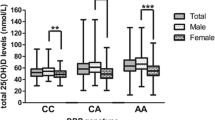Abstract
In a longitudinal analysis of the results of bone mineral density (BMD) screenings conducted in local communities, we examined the effect of lifestyle improvements on BMD and investigated the influence of allelic variations of the vitamin D receptor (VDR) and estrogen receptor (ER) genes. The subjects were 484 women (age, 24–80 years) who underwent BMD screenings at least twice between 1994 and 2002. We conducted BMD measurements of the lumbar spine by dual-energy X-ray absorptiometry and performed a simple questionnaire survey of lifestyle factors. Women receiving pharmacotherapy, or those with bone fractures, were excluded, leaving 338 women eligible for the study. They were retrospectively divided into three groups: (i) premenopause, women who were at least 5 years preceding menopause; (ii) perimenopause, women who were within 5 years before or after menopause; and (iii) postmenopause, women who were at least 5 years past menopause. There was no correlation at all between improvements of lifestyle factors (i.e., calcium intake from dairy products and time spent walking) and fluctuations in lumbar-spine BMD after 1, 3, or 5 years in the pre-, peri-, and postmenopausal groups. For women in the postmenopausal group, the PP genotype for the ER gene correlated with a significantly higher initial BMD than those with the Pp and pp genotypes (P = 0.04). After 3 years, presence of the TT genotype of Taq I of VDR gene polymorphism exhibited positive correlations (r = 0.29, P = 0.03) with the improvements in calcium intake and in lumbar spine BMD for the perimenopausal group, whereas the Tt genotype showed negative correlations (r = −0.48, P = 0.04). After 1, 3, and 5 years, presence of the Tt genotype showed a tendency toward a negative correlation with the increases in calcium intake and in lumbar spine BMD for the pre- and perimenopausal groups, although almost of these were not significantly different. In this study, we could not prove a positive correlation between the improvement of lifestyle and the fluctuation of BMD within a 5-year timeframe, although the polymorphisms within the VDR gene may have some influence.
Similar content being viewed by others
Author information
Authors and Affiliations
Corresponding author
About this article
Cite this article
Kurabayashi, T., Matsushita, H., Kato, N. et al. Effect of vitamin D receptor and estrogen receptor gene polymorphism on the relationship between dietary calcium and bone mineral density in Japanese women. J Bone Miner Metab 22, 139–147 (2004). https://doi.org/10.1007/s00774-003-0462-2
Received:
Accepted:
Issue Date:
DOI: https://doi.org/10.1007/s00774-003-0462-2



